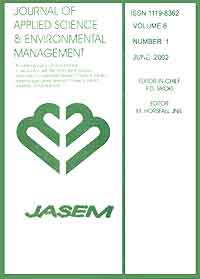
|
Journal of Applied Sciences and Environmental Management
World Bank assisted National Agricultural Research Project (NARP) - University of Port Harcourt
ISSN: 1119-8362
Vol. 22, No. 10, 2018, pp. 1625-1630
|
 Bioline Code: ja18273
Bioline Code: ja18273
Full paper language: English
Document type: Research Article
Document available free of charge
|
|
|
Journal of Applied Sciences and Environmental Management, Vol. 22, No. 10, 2018, pp. 1625-1630
| en |
Level of Organochlorine Pesticide Residues in selected Consumable Vegetables commonly sold in Benin City Markets
ATUANYA, EI & ONUOHA, T
Abstract
This research studied the levels and human health risk assessment of pesticide residues in consumable
vegetables such as watermelon, cucumber and onions commonly sold in Benin City markets. A total of twenty-five
organochlorine pesticide (OCP) residues in these samples were analyzed using with gas chromatography- electron
captured detector (ECD).The estimated acceptable daily intake (EADI) of gamma lindane concentration in fruit vegetable
(watermelon, onions and cucumber) was determined based on European union (EU) and United States Agency of Toxic
Substances and Disease Registry (ATSDR) standards, using two population age groups (child and adult). The results
revealed the levels of organochlorine pesticide residues among the fruit vegetables (watermelon, onions and cucumber).
Gamma lindane had the highest value of 0.0002mg/kg among the OCP residues detected in fruit vegetable (watermelon).
Onions and cucumber were below detection limit (0.00±0.00). The study, thus suggest that OCPs concentration (gamma
lindane) in watermelon is unsafe for human. The study therefore calls for continuous monitoring of agricultural farmlands
because continuous exposure to pesticide contaminated food products sold in Benin City markets (watermelon) could
affect the health of consumers.
Keywords
Pesticide residues; watermelon; cucumber; onions
|
| |
© Copyright 2018 - Atuanya and Onuoha
|
|
